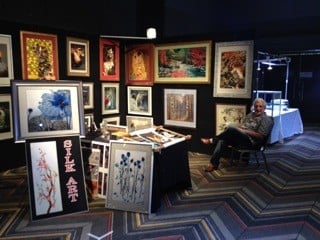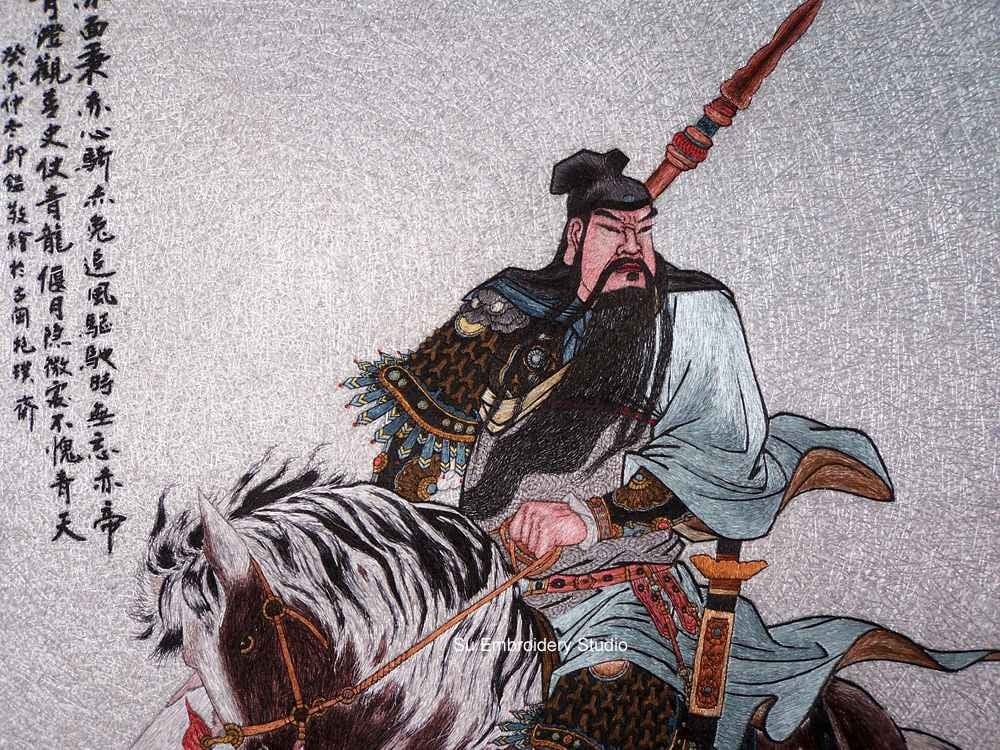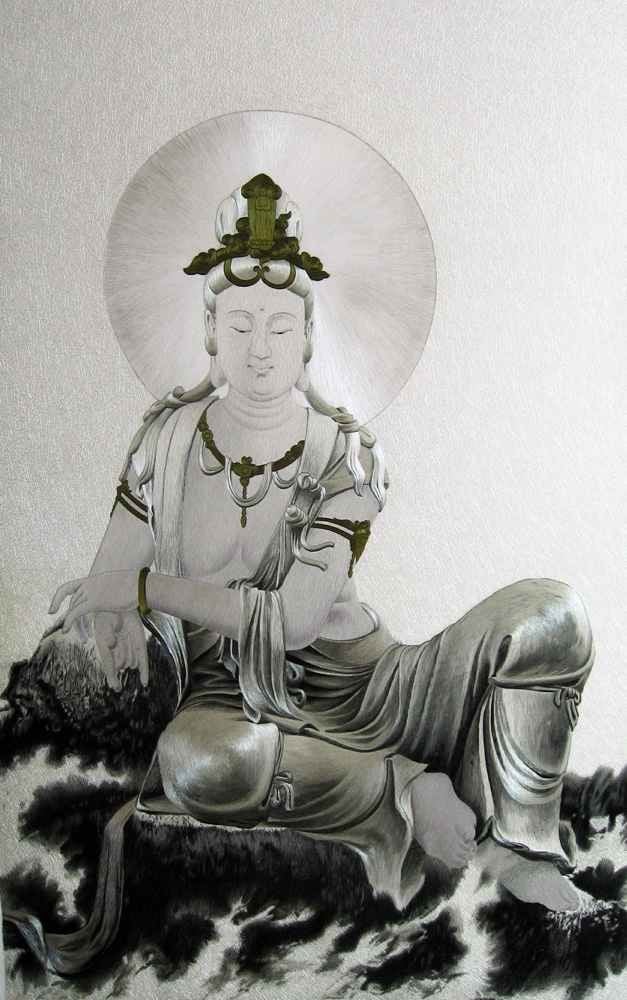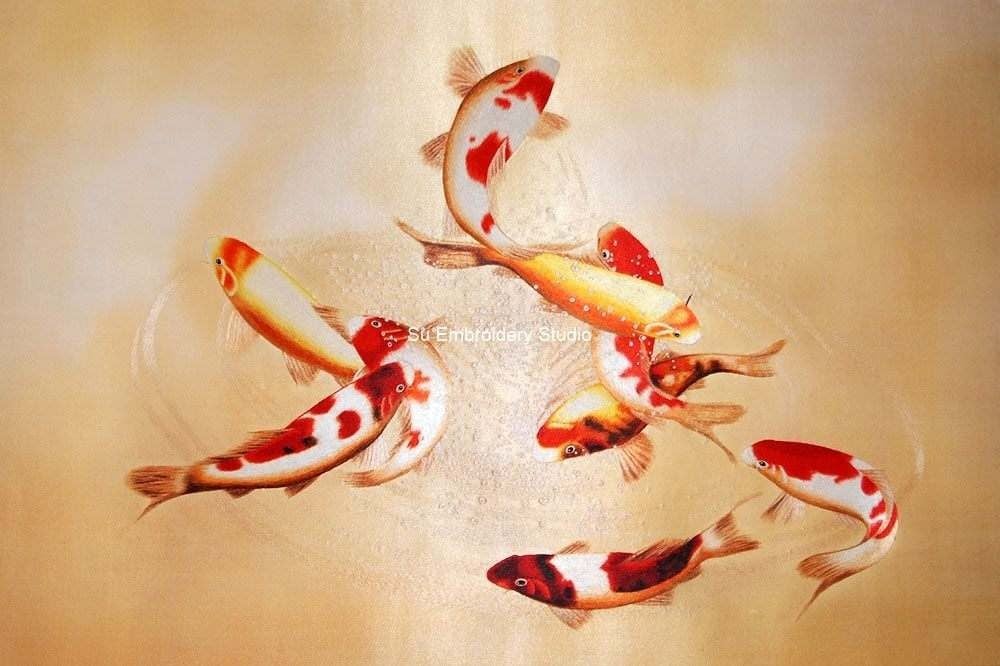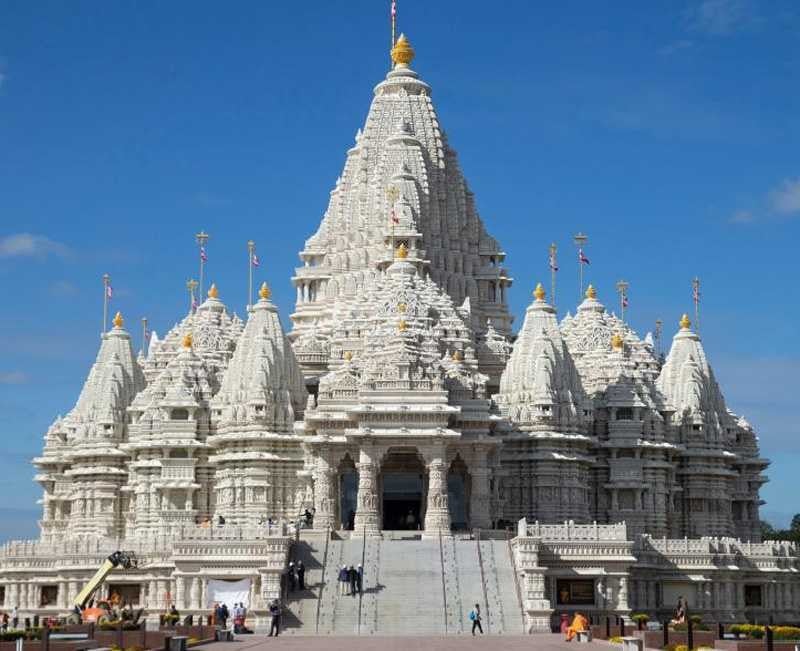by Mary Corbet, Independent Arts and Crafts Professional
Needle painting – the art of “painting” with a needle and thread – is one of the most complex forms of hand embroidery. Realistic needle painting is an art mastered by Chinese embroiderers in Suzhou, China. In this region of China, embroiderers create the most amazing masterpieces by hand using tiny silk threads.
I recently had cause to be in contact with Chunhua Mao, the founder of Su Embroidery Studio, and he graciously sent the photos of some of the needle painted works at his studio that caught my eye. I asked if I could share them with you. You see, if you’re like me, you will be filled with wonder and delight when you see the detail and beauty of these embroidered pieces. To think that they are worked completely by hand with such accurate and perfect detail! It boggles the mind!
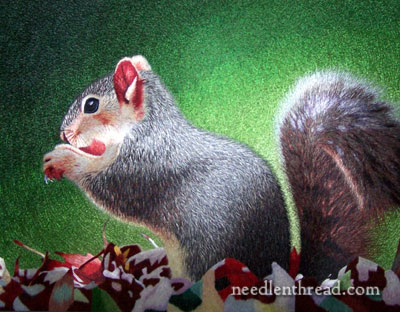
Embroidering animals has been a constant fascination of mine, and lately, the topic has been the subject of a small “debate” between me and a friend. We’ve been discussing the merits of realistic vs. stylized animals depicted in embroidery, and how to achieve realism. Though there are a couple points we don’t agree on, what we do agree about is that embroidering an animal and making it look real is really, really difficult. It takes time, patience, and practice. And more practice. And a still more practice. If you peruse the catalog at Su Embroidery Studio, you’ll come across quite a few needle painted animals, and oh my! Are they a wonder to behold! This squirrel immediately caught my eye: the perfectly realistic coat, the fluffy tail, the glint in the eye, and how the imagined light source reflects on the critter. Have you ever seen a squirrel embroidered with this type of detail?
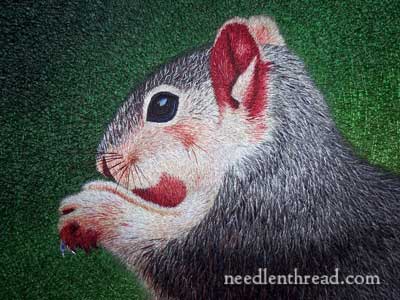
Look at the squirrel a little closer and and you’ll see the layers of shades of silk thread that make up his coat and his face. The embroiderers use strands of silk that they separate into tiny strands of filament, to achieve this kind of detail. Master embroiderers sometimes separate the threads to the point that the thread is barely visible to the human eye. On the Su Embroidery Studios website, you’ll find plenty of articles that discuss Suzhou silk embroidery and the ways the artists achieve these realistic results.
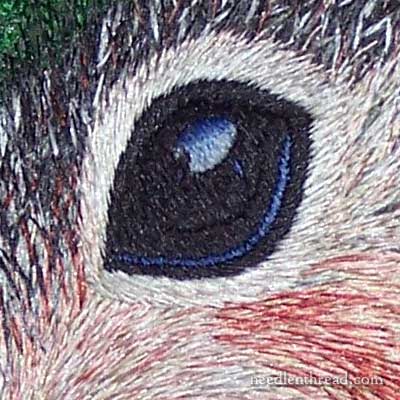
You can see in this little fellow’s eye the amount of shading in that glint alone. You can also see how accurate the direction of the stitching is around the eye, below, and above it. When the embroiderer moves onto the squirrel’s coat, notice that the stitches become more irregular. The embroiderer does not stick to the standard and more regular long and short stitch – to achieve realism, the embroiderer uses what the Chinese call “hairy stitch.”
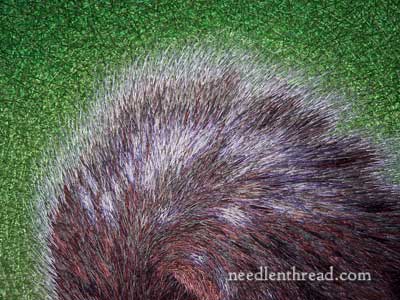
The tail is a beautiful example of hairy stitch. Note, too, the number of colors used in the tail. Chunhua Mao explained to me color selection is up to the embroiderer, who chooses the colors needed as the piece progresses. They don’t go by a color key or a pre-selected palette of colors. Colors are chosen on the spot, as the embroiderer determines the need!
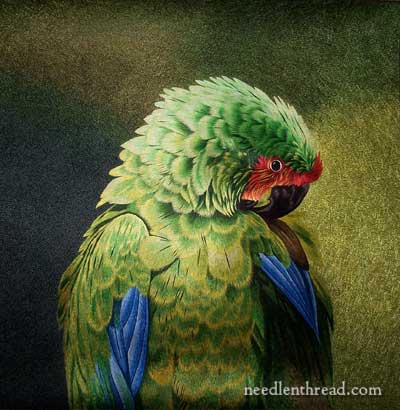
I have a weakness for embroidered birds, and a love of tropical birds. So this fellow caught my eye, too.
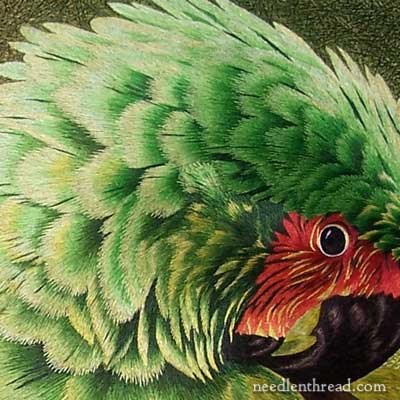
The layered feathers are perfect – the perfect amount of “fluffing” for a preening parrot.
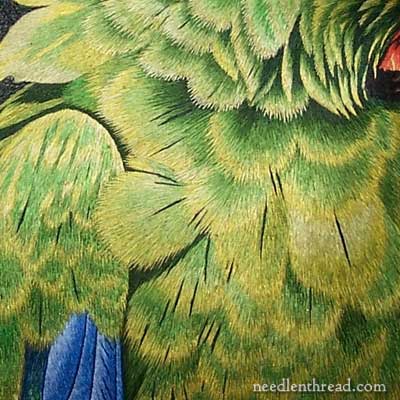
See the little dark dashes mixed in with the feathers? And notice the neck feathers up close, too!
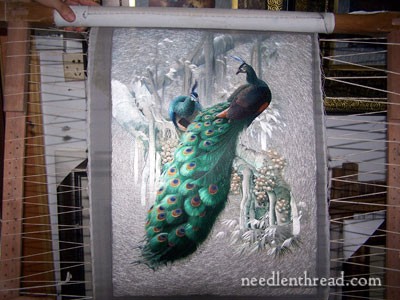
I love seeing the pieces mounted on their frames – evidence of the hand embroidery artist at work! The frames are set up much like slate frames. Note that the backgrounds of these pieces are all hand embroidered as well – the whole canvas is solidly embroidered by hand. The icy-looking background behind the peacocks is the ideal stage to show off those glorious feathers.
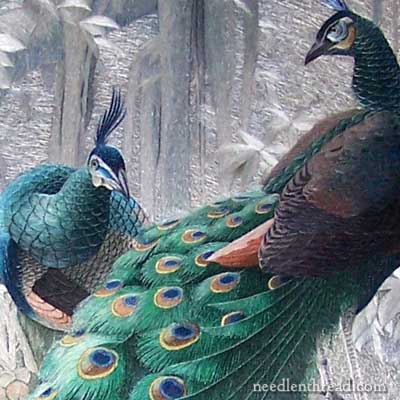
Besides the tail feathers (which are always the peacock’s show-stopper), look at the detail on both peacocks’ bodies!
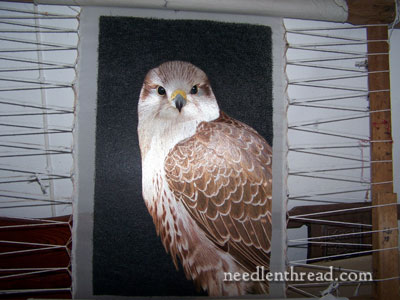
Here’s another piece on a frame – this time, note the piercing eyes and the “light” on the bird, in contrast to the dark background.
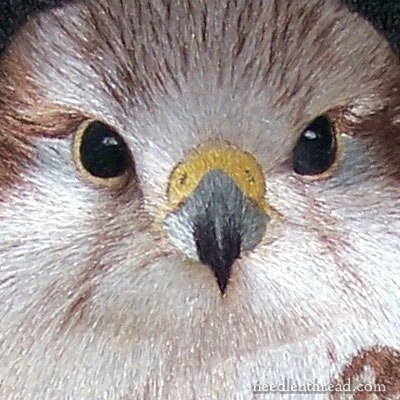
Notice that the eyes are not exactly the same. The eye on the right has a bit of a ring on the lower edge, further contributing to the realism by reflecting the imagined light source.
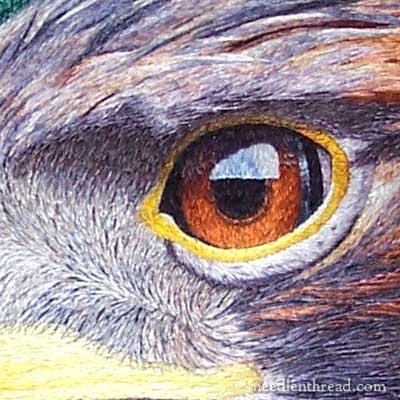
Speaking of reflections in the eye, this eagle’s eye looks like glass. Besides the larger “glint,” notice the tiny lighter stitches to the right and left of the glint that carry out the illusion of a real eye.
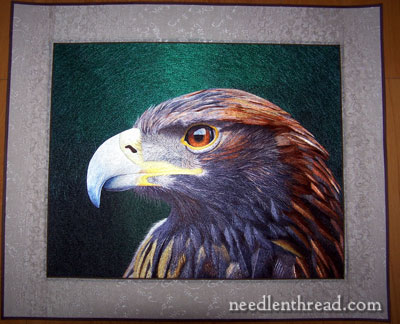
Photograph? Painting? Embroidery?! It’s hard to tell, isn’t it?
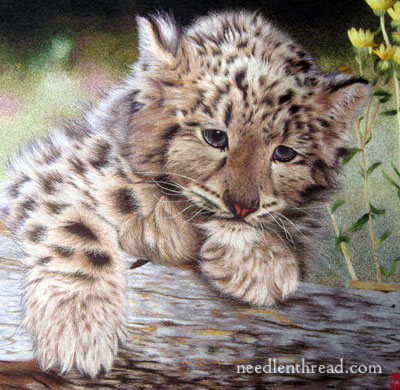
Now, this little creature should melt your heart! Remember that the background is solidly embroidered. Notice the “bokeh” effect in the background, with the foreground flowers more in focus, and then clarity of the log, and of course, the kitty himself.
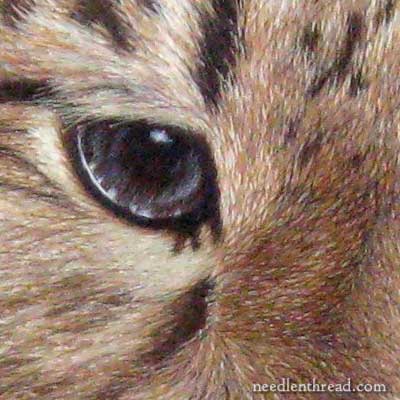
Another perfect eye. Look at the depth in that eye!
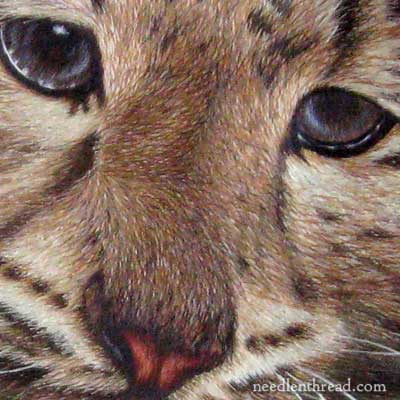
And both eyes together – what an expression!
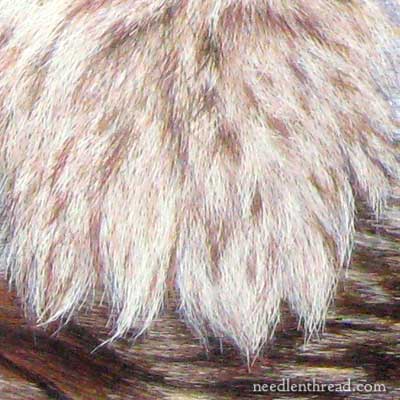
Check out the layering here that achieves the furry paw – it is perfection! Look at the tips of paw – the little tiny threads swishing to the sides, the layers of light over dark.
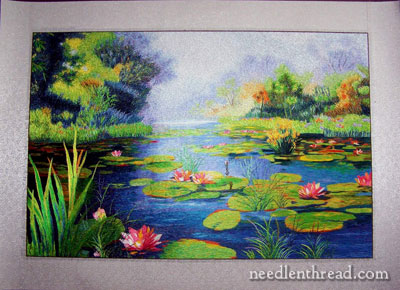
The embroiderers at Su Embroidery Studio also work landscapes. This, in fact, is an example of one of their ready-made Fine Quality silk embroideries that can be purchased from the studio. There are three levels of quality sold through the studio – “Fine Quality” “Top Quality” and "Masterpiece". Both are entirely hand embroidered, but the top quality works utilize more layers of threads and finer split threads, and are therefore more elaborately detailed and take longer to create. The fine quality needlepaintings are stunning, too. In this landscape – titled “Meadow of Lights” – what strikes me especially are the use of colors, the reflections on the water, the depth of color in the water, and the somewhat Impressionist look, with the very “Monet-ish” waterlilies.
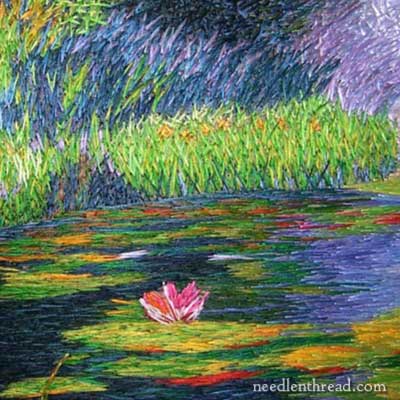
The sense of Impressionism is driven home even more when the piece is seen up close. Clarity is lost in the sketchiness of the stitches, but that sketchiness achieves the look of the shadow and light in the embroidery. Look, too, at the various colors in the water.
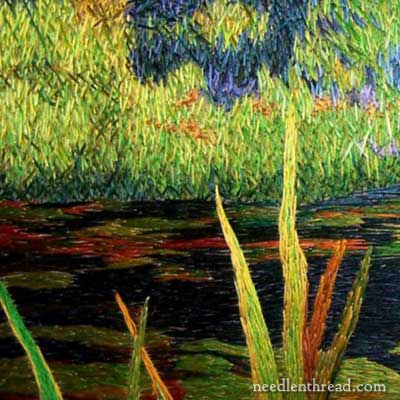
Notice how the shadows deepen on the edge of the lake, but the plants in the foreground are vivid and sharp.
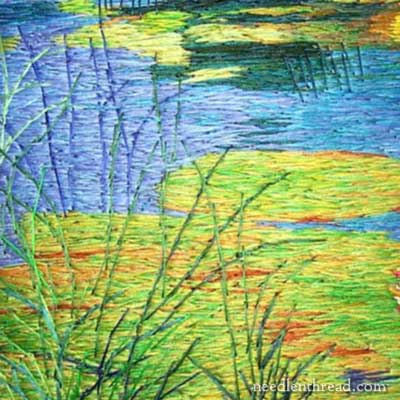
The reflections in the water are achieved in a number of ways: the “mirror” of the grass, worked in the blues, the darker green shadows of the overhanging bank, the vertical sketching of reflected grass along the edge.
The website of Su Embroidery Studio is definitely worth a visit! You’ll notice that they take custom embroidery orders, working from photographs. They also recreate master artworks in embroidery with astonishing accuracy. And, as mentioned above, you’ll also find some good reading on the site, especially under “Chinese Hand Embroidery ABC.” A couple things you should not miss: the article on the difference between hand and machine embroidery, with photos to illustrate, and a close look at Su Embroidery. While on this page, take a look at the piece titled Glassware, and click the link to view the enlarged picture. It’s is stunning!
I am constantly amazed by the vast world of textiles. The rich history and tradition of Chinese embroidery is fascinating, and it is good to know that this tradition carries on in the silk embroidery of Suzhou and in the work of the artists at the Su Embroidery Studio.
Thanks for the photos, Chunhua Mao, and for the opportunity to share them with my readers!
--This article is from Mary Corbet's blog at
http://www.needlenthread.com/2011/01/needlepainting-hand-embroidery-in-silk.html
* Su Embroidery Studio updated the website in January 2024. Some pages mentioned in the article above may have been removed. But you can still find them by searching in SES's blog.
by Su Embroidery Studio (SES), Suzhou China
SES is dedicated to Chinese Silk Embroidery Art and High-End Custom Embroidery
Find SES's embroidery work at Chinese Silk Embroidery for Sale.








